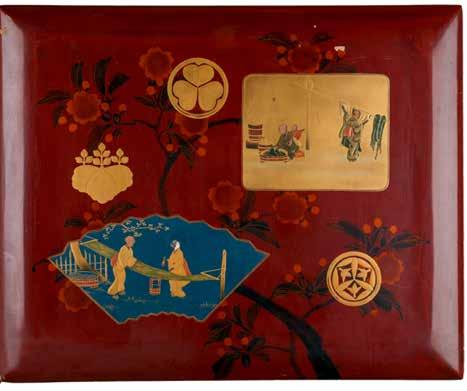A dish best served cold: the Akō incident and the forty-seven rōnin in print
David Forrest and Russell Kelty
It is said that the sweetest food, if left untasted, remains unknown, its savour wasted. The same holds true of a country at peace: the loyalty and courage of its fine soldiers remain hidden, but the stars, though invisible by day, at night reveal themselves. (Treasury of Loyal Retainers [Kanadehon Chūshingura], Act 11)
Of all the spectacular tales of loyalty, revenge and death none resonates more profoundly in Japan and around the world than the Akō incident (Akō Rōshi, 1701–03), more commonly known as the revenge of the forty-seven rōnin. The Akō incident took place during the ‘golden age’ of the Edo period, known as the Genroku era (1688–1704), when a century of peace fostered a blossoming of art and culture. It also marked the transition of the samurai from their primary function as warriors to bureaucrats and administrators of regional domains. Tantalising aspects of the incident immediately inspired fictionalised accounts on the puppet (bunraku, jōruri) and Kabuki stages in Edo, Kyoto and Osaka, the most famous of which, Treasury of Loyal Retainers (Kanadenhon Chūshingura) is one of the most popular plays of all times. Throughout the Edo period (1615–1868) the Akō incident continued to spark controversy and debate. In the eighteenth and nineteenth centuries it was translated into numerous languages in Asia and Europe. For over 300 years the story of the forty-seven rōnin has been retold endlessly on the stage, in print and on the large and small screens, transforming it from a national legend of Japan to an international phenomenon. The Akō incident began in Edo in 1701, the seat of the military government (bakufu). The powerful daimyo of Akō domain (presentday Hyōgo prefecture), Asano Naganori (1667–1701), was obliged by the shogun, Tokugawa Tsunayoshi (1646–1709), to arrange a suitable reception for the imperial envoys from Kyoto. To assist Asano with the strict protocols of the event, the bakufu’s highest ranking master of protocol, Kira Kozunosuke (1604–1702), was assigned to instruct him in matters of etiquette. It is likely that Kira expected compensation for his instruction, while Asano believed it was simply his duty. The contempt each held for the other erupted after Kira insulted Asano, prompting the latter to draw his sword and strike Kira in the face in the Corridor of Pines at Edo Castle. While Kira was not mortally wounded, the act of drawing a sword and striking a man of significant status and in the shogun’s residence was against the law and transgressed every reasonable expectation of civil conduct among samurai. 58
1 Columbia University, Chûshingura on stage and in print, exhibition, 2003, <http://www.columbia. edu/~hds2/chushingura/exhibition/pt1.html>.

















